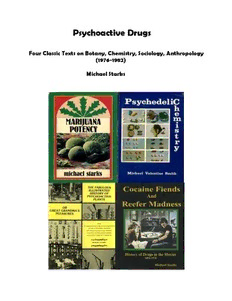
Psychoactive Drugs. Four Classic Texts (1976-1982) PDF
Preview Psychoactive Drugs. Four Classic Texts (1976-1982)
Psychoactive Drugs Four Classic Texts on Botany, Chemistry, Sociology, Anthropology (1976-1982) Michael Starks © Michael Starks (2016) ISBN 978-1-5323-2882-4 nd 2 Edition (2017) These books were written some 40 years ago, when the world was relatively simple. No cel phones, no internet, no PC's, no home VCR, CD or DVD--not even decent copy machines most places. As the psychedelic 60's helped my mind to expand far beyond the physiology department at Berkeley, I immersed myself in media of all kinds and was especially fascinated by early films dealing with psychoactive drugs. It was laborious in the extreme to do library research and I spent thousands of hours in the Berkeley University Library poring through books. I saw many of the films in the film book on late night television and kept notes on file cards. I was especially interested in the older films and they were the hardest to find info about and often impossible to see--many had vanished. I purchased some from catalogs of 16mm films. My favorite find was "Hemp for Victory" which I found only in a catalog entry in the Library of Congress. They claimed no knowledge of it, so I wrote to the maker--The U.S. Dept. of Agriculture and finally got a 16mm print. I had it copied to 3/4 and VHS tape and it quickly spread worldwide. Now you can stream it from Youtube. There is even a Wikipedia entry, which fails to note that these came from me. I was invited to Amsterdam by a group funded by the government where I gave a lecture on drug films and showed a dozen which I had collected. I researched many different topics simultaneously and the wrote other books The Fabulous Illustrated History of Psychoactive Plants, Marijuana Potency (now Marijuana Chemistry) and Psychedelic Chemistry. Eventually I gave all these research materials as well as much else on the history of psychoactives to the Fitzhugh Ludlow Memorial Library in San Francisco, which was sold to a European collector. I intended to write volumes on horror and science fiction films. It was a rare privilege living in Berkeley and San Francisco during the psychedelic revolution. I had many other interests and eventually gave up on films and drugs in favor of 3D imaging and spent a year in the Berkeley Library hand searching the entire US Patent Index. In 1979 I cofounded StereoGraphics Corporation, which provided the first significant commercial video and computer systems for viewing 3D images with LCD shutter glasses and am coauthor of its first patent on 3DTV. Some 20 years later it was bought by RealD and its technology became the basis for the 3D digital cinema, which led directly to home 3DTV and the subsequent worldwide 3D mania. In 1989 I started 3DTV Corporation and made the front page of the Wall Street Journal when I introduced the world's first electronic home 3DTV system at the 1990 CES. This period of my life is covered in the ebook 3DTV and 3D Movie Technology Selected Articles 1996-2016 446p(2016). Subsequently I indulged a lifelong interest in philosophy and psychology and science and have written about 60 detailed reviews and articles, especially of books by and about Wittgenstein, Searle and other students of behavior. This ten year period of my life from age 65 to 75 is covered in the ebook Philosophy, Human Nature and the Collapse of Civilization -- Articles and Reviews 2006-2016 662p (2016) and the philosophy work only in The Logical Structure of Philosophy, Psychology, Mind and Language in Wittgenstein and Searle 367p (2016). Powered by TCPDF (www.tcpdf.org) It has been said in truth that a picture is worth a thousand words. This belief, insofar as many illustrations of the psychoactive plants and their use is concerned, is absolutely true. Michael Starks' The Fabulous Illustrated History of Psychoactive Plants stands out as a superb --- and so far as I am aware the only --- example of a pictorial review of the history of the use of psychoactive drugs. A survey of the 189 pages of illustrations, mostly from the second half of the 19th Century, puts the reader in a really personal closeness to the sources, preparations and uses of stimulating, narcotic and other-wise intoxicating drugs of this and, to a lesser extent, earlier periods. It is a joy to become so familiar with what the Germans call the Genussmittel ("tool of enjoyment") through pictures critically chosen from the literature --- many of which come from obscure or rare sources unavailable to most readers. The book is extremely valuable since it represents a tremendous knowledge of the literature and a critical handling of the information preserved for posterity in illustrative form. This contribution is apprepriately dedicated to Mordecai Cubitt Cooke who, in 1860, published The Seven Sisters of Sleep, one of the earliest popular books on psychoactive drugs. There are portraits of some of the early leaders in the study of psychoactive drugs: Cooke, James F.W. Johnston, Carl Hartwich, Louis Lewin and Alexander Tschirch. Michael Starks is to be congratulated in putting together this book --- a work of love, full of historical wealth and yet of current pertinence. I salute his dedication of this gift to the literature of psychoactive plants. Richard Evans Schultes, Ph.D., FMLS Jeffrey Professor of Biology & Director, Botanical Museum of Harvard University (Emeritus)
